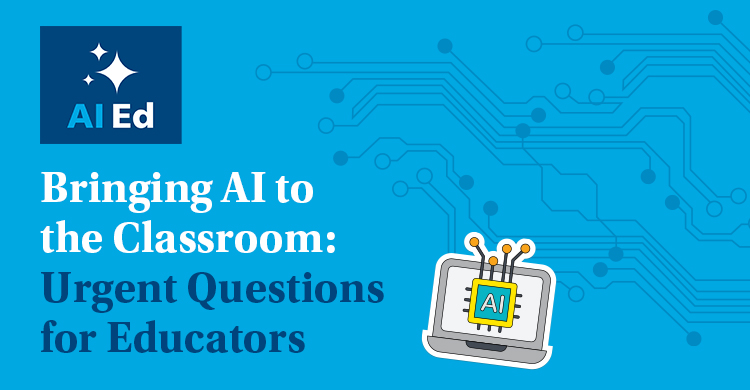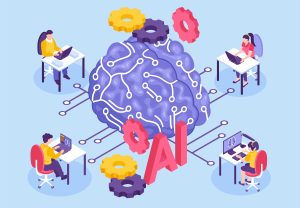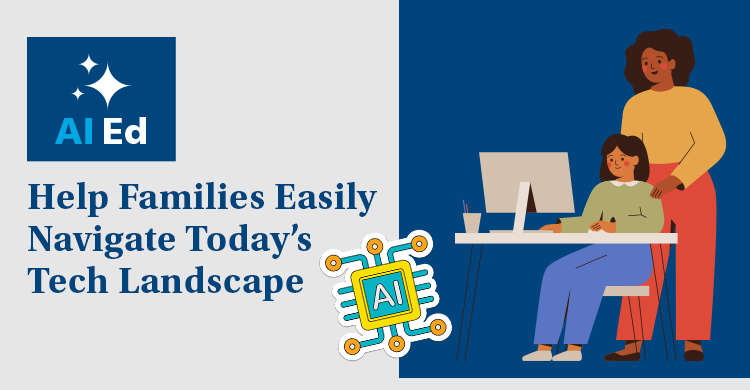Just when we thought artificial intelligence tools like ChatGPT were going to make human thinking obsolete, they have educators raising more questions than answers. But this is a good thing: questions can lead to new thinking and innovative practices. To dive deeper into these pressing issues, read on to explore Bringing AI to the Classroom: Urgent Questions for Educators.
Remember that the school experience is not (or should not) be the same as when the adults in the building were in school. Local and global events, like the COVID-19 pandemic, impact the perspective and behaviors of educators, students, families, and even the larger community. Advances in technology, like the creation of the iPhone and the rise of social media, influence literacy practices and how we access and share information.
Kids experience the world as it currently is, and it is our responsibility as educators to engage students in learning that is relevant to the times they are living in.
Nine new questions about artificial intelligence and education
The rise of artificial intelligence (AI) tools, specifically ChatGPT, is an event that has caused a “stir” in the field of education. Some approach this new technology with a willingness to learn and integrate it into instructional practices, but others are more hesitant and weary of AI’s potential impact on how students generate ideas and engage in the writing process. Mixed reactions are completely understandable with an advancement that challenges what humans typically do.
I’ve had the opportunity to formally speak about AI and ChatGPT with various stakeholders in different forums: teachers, administrators, parents and caregivers, high school and college students, and university professors. There are trends to these conversations—new thinking and questions that beg us to consider the possibilities with artificial intelligence.
Here are some questions and talking points that may help your team engage in a productive discussion about artificial intelligence in the classroom and reach a consensus about how to best approach what will inevitably filter into schools.
What does it mean to be a critical user of AI?
Users should be highly aware that output from chatbots like ChatGPT is, in fact, artificially generated. Users should know that information isn’t always accurate and may not be generated in a way that communicates the intended meaning. How do we embrace this new era of critical thinking in teachable moments? Are there opportunities to reflect on how fact-checking, evaluating sources, and synthesizing information are addressed in today’s curriculum?
What language skills are imperative to students’ literacy development when considering using AI in the classroom?
When interacting with a large-language model like ChatGPT, the user’s specificity in language when prompting is integral to the process; language around questioning, developing ideas, and soliciting specific feedback may call for new teaching points in various subject areas. The use of academic vocabulary in prompting will vary depending on the task. Exercising control over language gives the user of AI agency.
What kind of thinking are we asking kids to do?
If AI can think through an “assignment” for a student, we may consider reflecting on the levels of thinking most assignments in courses ask students to engage in. Students should be invited to think creatively and critically when they feel they have a stake in what is being taught and assigned. If students have a personal investment in what they are working on, they may be less inclined to rely on a robot for completion.
What kind of writing are we asking kids to do?
ChatGPT can be used as a tool to actually get better at writing. There are endless possibilities to use it for lessons in structure, craft, conventions, and elaboration. But it’s a writing partner, not a substitute for the writer, and students need to be taught this. Additionally, educators may consider reflecting on what students are asked to write about. Is every student required to write about how a theme emerges in Macbeth? Imagine how many accounts of that question are stored in cyberspace. If we challenge kids to write about authentic ideas relevant to them, there may be less of a chance that AI-generated writing will give them the answer.
What instruction do we have in place that addresses critical reading, fact-checking, and analysis of reliable and valid sources of information? How might curriculum or instruction need to change to address these skills in the world of AI?
These are not new skills, but they need to be addressed within the context of using AI. Perhaps curriculum teams could be formed by grade level or department to audit curricular areas where it may be appropriate to integrate explicit teaching of AI tools and the skills needed to use them ethically, responsibly, and creatively.
For more information on critical learning skills that can help students adapt to an increasingly AI-driven world–or any rapidly changing environment–visit our blog, “Five Critical Skill Sets and Their Instructional Implications.”
How can we vary approaches to assessment so that there isn’t overuse or an overreliance on AI?
There are many ways to gauge students’ understanding of content and curricular themes. Presentations, debates, physical designs, visual representations, demonstrations, teacher-student conferences, and peer conferences are all ways to evaluate student learning and progress. You can find many more strategies by visiting our Student Engagement and Instruction blog topics.
How can AI help teachers to differentiate learning material and support various student needs?
Teachers undoubtedly need to have a strong foundation in instructional strategies that promote student learning and why differentiated instruction is necessary in classrooms. Teachers develop their skill set through preservice coursework, reading, observing other teachers, engaging in professional development, and reflecting on their own teaching experiences. There are no substitutes for this type of work, and prior experiences can inform teachers’ use of AI tools for planning.
Teachers also need to know their students’ needs and the types of support that may benefit them before approaching AI use. AI tools can generate scaffolded questions, vary the text complexity of reading material, develop prompts for generating ideas, translate text into different languages, and produce models similar to the assignment students may work on. AI can be a digital teaching assistant so that teachers can focus on the instruction and conferring with students in real-time to move their learning forward.
How does AI widen access to writing support?
The concept of students getting help with writing is not new. While all students have access to their teachers during the school day, only some have access to additional support from adults at home. Familiar questions are: How can I say this? Can you read this and tell me what I need to fix? What else should I add?
While conversation about writing can be helpful, AI may offer a digital conversation to those who don’t have adults available for support.
What privacy and security measures should be considered when using AI tools in school?
It is important that your technology team is involved in planning for using AI in school. There are education laws dedicated to data privacy. Teams will want to know the security and compliance measures of AI platforms the school is interested in using with education law.
While the content generated by platforms like ChatGPT is inherently artificial, this new technology is very much real. Involving multiple stakeholders in conversations about AI helps to generate responsible plans for use and to think creatively about the next steps for implementation.
Want to keep learning? Here are some additional, handpicked resources on the emerging role of artificial intelligence in education.
About the educator
Lorraine Radice, PhD is the author of Leading a Culture of Reading.







